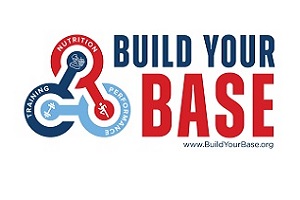NSAF athletes improvise at Project Triple Jump, 1st Clinic
Photos by Joy Kamani
“It’s a colorful event, the only event where you get to put on a real show on the stage,” says Coach Peter Pratt when you get him talking about his passion. “You have all type of characters. Triple jumpers are poetic, they are dancers, they are rhythmic and they come with lots of style and pizzazz.”
The “characters” in last weekend’s “show,” then, were the dozen high school hop-step-and-jump types who landed in the Dallas area (specifically, DeSoto) for the 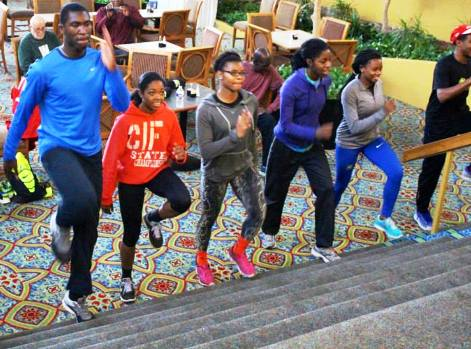 first leg (pun intended) of the National Scholastic Athletics Foundation’s 2013-14 Project Triple Jump Camp. And if you’re going to draw a show business parallel, it should be with something like “Night at the Improv,” because that’s what last weekend was all about: Improvisation.
first leg (pun intended) of the National Scholastic Athletics Foundation’s 2013-14 Project Triple Jump Camp. And if you’re going to draw a show business parallel, it should be with something like “Night at the Improv,” because that’s what last weekend was all about: Improvisation.
Temperatures on a typical late November Dallas day will be in the low- to mid-60s. In fact, the previous weekend had been very warm. “It went from 84 degrees the Sunday before to the 30s when we had the camp,” said Coach and NSAF Project Coordinator Macka Jones. And it wasn’t just the cold. The athletes had brought warm clothes, but the combination of the temperatures, driving rain and sleet, and strong, swirling winds simply rendered outdoor conditions not just uncomfortable, but downright risky, injury-wise, for sprinter/jumper types.
It all came to a head Friday morning, amidst the realization of the severity of things outdoors and the reality of the lack of an indoor facility for the first day – despite Coach Jones’ best efforts. He and Coach Pratt then did what the best coaches do in situations like this: They improvised.
Luckily, the lobby of the DeSoto Clarion Hotel was positively cavernous. Some indoor track facilities aren’t as big. On a quiet Friday late morning, 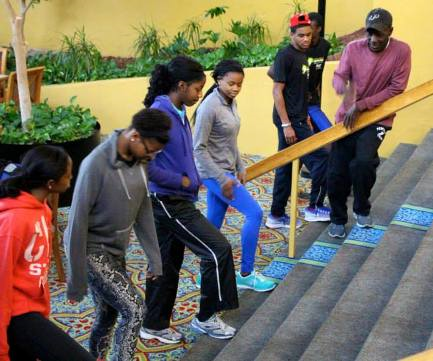 there were few guests to risk bothering. And, right before them was a broad, generous, carpeted flight of stairs leading to an intermediate landing area/lounge. It was just right for a variety of leg and hip drills that were fitting for the first morning of the clinic.
there were few guests to risk bothering. And, right before them was a broad, generous, carpeted flight of stairs leading to an intermediate landing area/lounge. It was just right for a variety of leg and hip drills that were fitting for the first morning of the clinic.
And so it went. The next day, the gym at DeSoto’s McCowan Middle School – where the track sessions were to have taken place – was available. The middle school’s facilities, larger and more generous than many high schools, were just right and with more improvisation, creating a mini-runway and using a high jump mat as a landing put, an excellent workout commenced.
Along with the planned series of classroom sessions, it’s fair to say that no one left the weekend feeling underserved, but rather looking forward to the December session in Ft. Lauderdale.
So who was there? Well, the three returnees to Project Triple Jump were on hand, lending their experience and leadership to the newcomers:
- Mt. Olive (N.J.) senior Keturah Orji
- El Paso Burges senior KeAndre Bates
- Columbus (Texas) junior Felicienne Axel
As has been detailed in previous stories, Orji and Bates are World Youth finalists (Orji with two medals) and top national returnees. Axel, who claimed a 3A state title and went over 40 feet as a soph, isn’t far behind.
As for the newcomers invited for the full program, here they are again:
- North Florida Christian (Tallahassee, Fla.) senior Darrielle McQueen
- Mountlake Terrace (Wash.) soph Chinne Okoronkwo
- Mission Oak (Talare, Calif.) soph Nashedah Mumin
- Cahokia (Ill.) soph Ja’Mari Ward
- El Paso Burges (Texas) frosh Arielle Mack
McQueen is in a group behind Orji as one of the best returning girls in the country and certainly one of the winningest. Okoronkwo, Mumin and Ward were arguably the three best 9th-graders in the nation last spring. And as for Mack, she was a newcomer to the sport last year as an 8th-grader who did well and has tremendous potential.
And, as was the case with the NSAF’s Kultan Keihas javelin clinic last month, there were others outside the committed “program athletes” who came on their own to Dallas and added tremendously to the weekend. They were:
- Boston College (Mass.) senior Jordan Samuels
- Big Walnut (Sunbury, Ohio) senior Olivia Smalls
- Bishop Dunne (Dallas, Texas) frosh Christian Cuellar
- East Ridge (Woodbury, Minn.) 8th-grader Allyson Weiss
The latter quartet of athletes had no problems blending in with the “program” athletes. Jordan Samuels, who noticed when fellow Massachusetts star (now 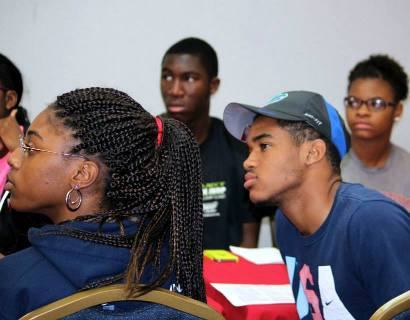 graduated) Carla Forbes was in the program and was inspired to get involved, said “It’s been great to be here with KeAndre and hang out with people like Keturah, and get to know them on more of personal basis than you see online.”
graduated) Carla Forbes was in the program and was inspired to get involved, said “It’s been great to be here with KeAndre and hang out with people like Keturah, and get to know them on more of personal basis than you see online.”
“I thought it was really fun,” added Allyson Weiss. “Everybody came together and all became friends.”
Also, a dynamic always hoped for is that the older, veteran athletes with some familiarity with the project will take some leadership and share what they know, while the younger, new athletes will be inspired and take the guidance.
A few of the youngsters and newcomers had to figuratively pinch themselves that they were surrounded by so much triple jump excellence. “It was so overwhelming at first, because I don’t even think I belong here ... it’s so mind boggling that I got accepted,” said Arielle Mack. “All of these athletes push me harder to do better.”
“You learn a lot from anyone who can jump further than you, and take tips from them,” said Nashedah Mumin. Added Olivia Small, “All of these girls have jumped so far and I 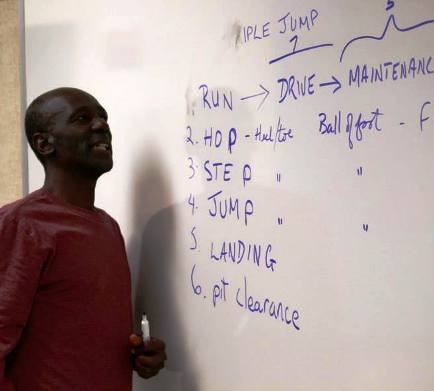 want to get there so bad! It’s a really good opportunity for me; I have not had a chance to spend a lot of time with people who are this outstanding in the event.”
want to get there so bad! It’s a really good opportunity for me; I have not had a chance to spend a lot of time with people who are this outstanding in the event.”
And, as KeAndre Bates pointed out, it’s a two-way street. “They watch me – and see the things I do wrong and things I do right and learn from me – and I can learn from them, too.”
Thursday began with a classroom session as the athletes (especially the newcomers) got to know Coach Pratt and each other, and Coach dispensed some of his wisdom on a variety of topics – including not only specific ideas related to triple jump, but also dealing with social temptations in college.
On Friday morning, additional last minute attempts to find a gym were made as the poor weather forecast was realized, and gloves were procured for some athletes who were lacking. But then Coach Pratt took action and got things rolling: “We did some things inside the hotel,” he explained. “You have to be creative. We couldn’t use the gym and the weather was nasty, so I had to do something inside the lobby here.
“It is always good to be able to improvise, because everything doesn’t go the way you want it to go ... I believe I’m creative enough to do some drills.”
By the end of the weekend, the athletes would agree about the benefits for being creative under adverse conditions. “The weather was a blessing in disguise,” said Chinne Okoronkwo, “because where I’m from it’s really rainy. I really enjoyed it, it gave me a lot of ideas how to deal with it.”
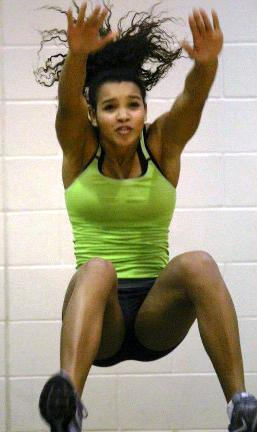 The afternoon saw the athletes in a classroom at McCowan as Coach Pratt dug deep into the technical aspects of the event, hitting on everything from the runup to the particulars of each phase.
The afternoon saw the athletes in a classroom at McCowan as Coach Pratt dug deep into the technical aspects of the event, hitting on everything from the runup to the particulars of each phase.
Then on Saturday morning, it was back to McCowan, this time to the gym. A variety of drills served as warmups, and strength and conditioning exercises. Actually, the aforementioned high jump mat would serve multiple purposes. First, the athletes practiced their runup and jump sequence on the soft surface of the mat, which forced them to put extra focus on body control. Then a runway was marked off by cones and tape, leading up to the HJ mat landing area, and the athletes performed 3-step, 2-step, and 1-step runups with jumps on to the mat.
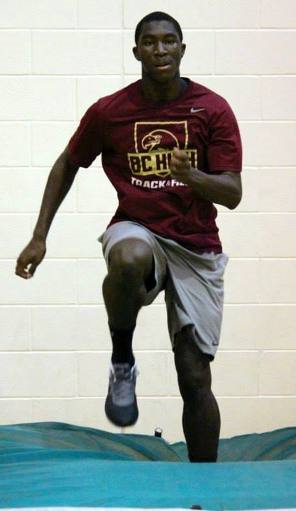 “Today was a good day,” said Coach Pratt later. “Even though we weren’t outdoors, we were able do some triple jump. We converted the high jump mat into the landing area, we did some jumping on the mat, and we did a wide variety of drills and things that will help them.”
“Today was a good day,” said Coach Pratt later. “Even though we weren’t outdoors, we were able do some triple jump. We converted the high jump mat into the landing area, we did some jumping on the mat, and we did a wide variety of drills and things that will help them.”
“It was beneficial to the kids,” added Coach Jones, summing up the two training sessions. “They saw they can train year-round with things around them every day.”
After lunch, it was back into the classroom, where Coach Pratt inspired the athletes to think about the event and themselves in a way probably most of them never had before. He made a list on the board of aspects of one’s life, which included Family, Culture, Health, Economics, Education, Religion and Politics. What did this have to do with triple jump? Coach Pratt was encouraging the athletes to consider the event within the context of the big picture of their lives, and how challenges in any of these areas could impact athletic performance. For example, he explained how Olympic boycotts from 1980 and other years had caused other athletes’ careers and lives to run off the rails.
In response, Coach Pratt illustrated how four “D’s” can keep them focused on their athletic journeys, even when life gets in the way: Dedication, Determination, Desire and Discipline.
At the end of the weekend, KeAndre Bates would point out that these classroom lessons were some of the 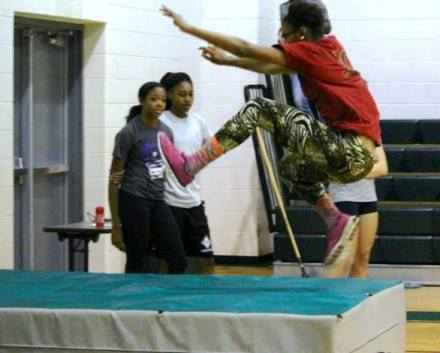 most important aspects of the weekend for him. Added Allyson Weiss, echoing several others’ sentiments: “I never thought about comparing everything in life to triple jump.”
most important aspects of the weekend for him. Added Allyson Weiss, echoing several others’ sentiments: “I never thought about comparing everything in life to triple jump.”
“I look at triple jump in different and more aspects,” said Darrielle McQueen, “and relate it to more things in life, especially the spiritual part.”
Finally, the afternoon also included delving into Coach Jones’ video library for footage of greats like Jonathan Edwards, Willie Banks, Françoise Mbango, Teddy Tamgho, Tiombé Hurd, Mike Conley and more.
After having some fun visiting the historic Fort Worth Stockyards district Saturday night, everyone came back for a final review session Sunday morning. The athletes all had a chance to reflect on what they had gained most from the 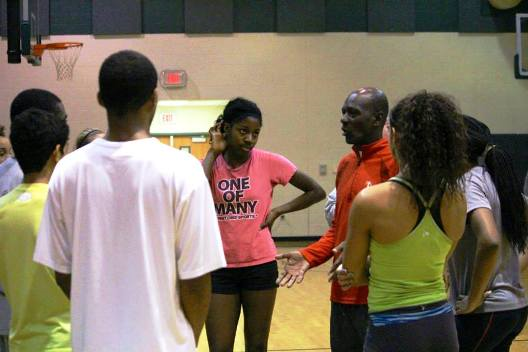 weekend, while Coach Pratt, Coach Jones and NSAF staff offered support and additional perspectives.
weekend, while Coach Pratt, Coach Jones and NSAF staff offered support and additional perspectives.
Summing it all up as well as anyone was Jordan Samuels: “Coach Pratt has helped make a lot of stuff more clear and definitely provided us with a solid base to be able to go back and do a lot of the things on our own – and help us improve as jumpers on a day-to-day basis.”
And the great thing now about this year in the program is that this Dallas weekend was just the beginning. In the past, the Bahamas trip was the beginning, the middle and the end. This time, Fort Lauderdale awaits the jumpers in late December, followed by the Bahamas immersion experience in Coach Pratt’s backyard in March.
“Overall, it is better that we have more camps this year,” said Keturah Orji. “We definitely have more time and we can focus on different things at each camp. Last year we didn’t have as much time to learn a lot.”
“We will be able to monitor progression from off-season, pre-season, and in-season, and we will see what they need throughout the year,” added Coach Pratt.
What would the Project Triple Jump athletes say to others who might learn of the clinics and camp this year and consider getting involved? “I would definitely tell them to join,” said Keturah. “It’s great to meet a lot of people from around the country that triple jump, and then working with Coach Pratt is really good and learning things here helps a lot.”
She should know!

